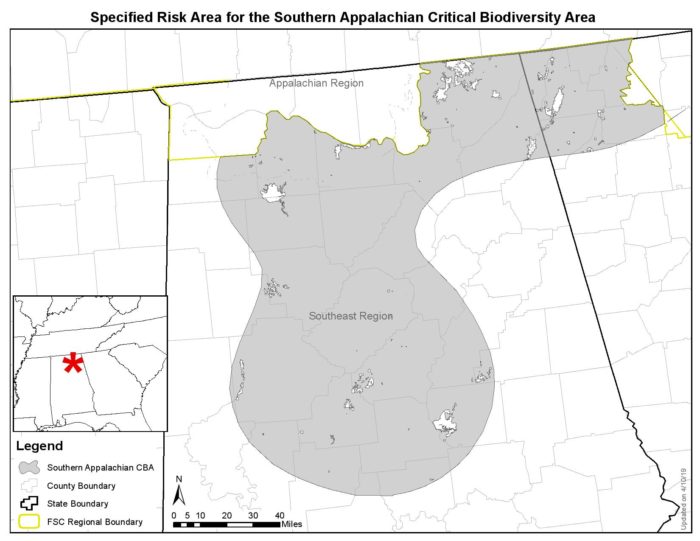Southern Appalachian Forests: A Critical Biodiversity Area

What is the Southern Appalachian CBA?
The Southern Appalachian Critical Biodiversity Area, as defined by the Forest Stewardship Council, resides mostly in north and north-central Alabama, and some of northwest Georgia. There are several specialized habitats in this area due largely to the overlap of three distinct ecoregions: Ridge and Valley, Southwestern Appalachians, and Interior Plateau. Additionally, streams and rivers in the Southern Appalachian ecoregion boast the highest aquatic biodiversity in North America (EPA 2015).

Threats Facing Aquatic Ecosystems in Southern Appalachia
While there are several factors threatening the health of the forests and aquatic systems in this region, one of the largest threats is non-point source pollution (NPS). NPS pollution occurs when pollutants are released over a wide area and cannot be traced back to a single source. Some of the most common aquatic pollutants that are attributed to silvicultural activities are sediments and chemicals (i.e. herbicides and pesticides). NPS pollution is responsible for 70 percent of the degradation of streams and aquatic systems in the Southeast (Potter et al 2004). In fact, the increase in sediment and chemical pollution within some watersheds of this region are correlated with a 20-40% decline in species richness and diversity. Aquatic invertebrates have been negatively affected by NPS pollution and many are eliminated due to excess sediments covering surfaces such as rocks that are necessary for nesting and foraging, or due to decreasing amounts of dissolved oxygen in water bodies (Voshell 2019). Controlling NPS pollution in silviculture is critical to maintaining water quality and aquatic biodiversity in the Southern Appalachians (Potter et al 2004).
Further reading
Alabama Department of Conservation and Natural Resources. “Aquatic Biodiversity Center.” Outdoor Alabama.
Environmental Protection Agency. (2015). Southern Appalachians ecoregion national rivers and streams assessment.
Fisher et al. (2000). The relationship of land use practices to surface water quality in the Upper Oconee Watershed of Georgia. Forest Ecology and Management, 128(1–2), 39–48.
Griffith, G.E et al. 2001. “Ecoregions of Alabama and Georgia (Color Poster with Map, Descriptive Text, Summary Tables, and Photographs).”
Hart, Justin L., Arvind A. R. Bhuta, and Rebecca M. Schneider. 2011. “Canopy Disturbance Patterns in Secondary Hardwood Stands on the Highland Rim of Alabama.” Castanea 76: 10.
Hartsell, Andrew J. 2018. Alabama’s Forests, 2015. Asheville, NC: US Department of Agriculture Forest Service, Southern Research Station.
Monroe, Jeremy. (2012). Appalachian rivers: streaming with life. National Wildlife Federation.
Southern Group of State Foresters. 2014. “BMP Management Measures.” Southern Group of State Foresters.
Resources
Stay tuned for more information coming soon
Stay Informed
about our recent projects and upcoming events.
